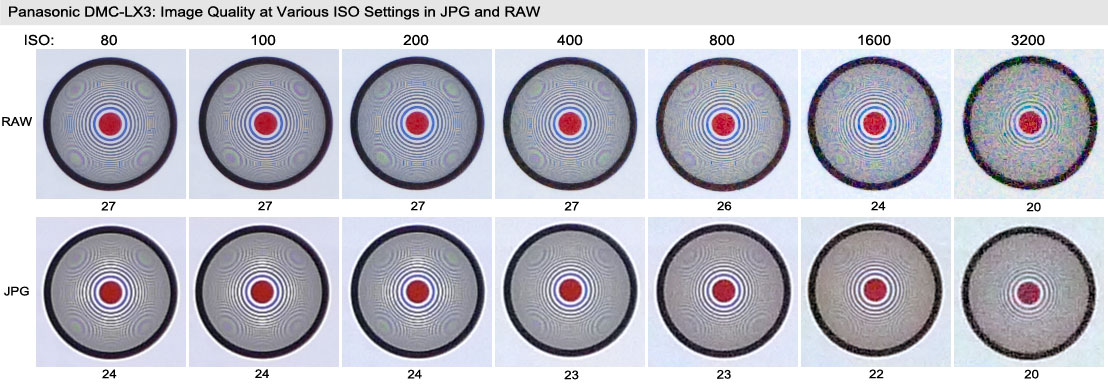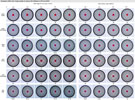
Panasonic Lumix DMC-LX3
| Aperture Range [f] | 2.0-2.8 to 8 | Max Resolution | 3648x 2736 (10M px) or 3776 x 2520 (9.5M px) |
| Dimensions | 108.7 x 59.5 x 27.1 mm | Other Resolutions | Multiple in 4:3, 3:2 and 16:9 aspect ratios |
| Weight | 265 g (9.3 oz) | Sensor Size, Pixel Density | 7.92 x 5.94 mm, 24 Mpx/cm2 |
This is a 10.1 megapixel camera if recorded in 4:3 aspect ratio. There are several smaller resolution settings, as shown below, with the average resolution in hundreds of line widths per picture height (LW/PH) given below each chart.
The largest theoretical resolution is 27 (x100 LW/PH). In the picture above it reaches 26 in RAW mode (it sometimes reaches 27, see f-stop dependence) but only 23 in JPG mode (RAW and JPG shots were made simultaneously), indicating that the jpg-saving algorithm has some problems, as also seen in Canon cameras. On lower resolution modes the observed resolutions match theoretical resolutions in the center charts (in the lowest resolution, number 5 is in parenthesis as this type of test has a minimum detectable resolution of 10).
Lumix DMC-LX3 has one RAW recording mode, at the highest resolution, and 9 JPG styles, called "Film" modes. They are Standard, Dynamic, Nature, Smooth, Vibrant, Nostalgic, and 3 other black & white modes, all varying in color saturation and contrast, but not in resolution. The samples are shown below. The top is the center chart, the bottom is the entire frame picture, and above it is a cropped center part of this picture.

Although the resolution read from the chart is higher in RAW than in any JPG modes, a photo of a landscape looks seemingly worse in RAW. There are at least two factors that cause this. One is that RAW is not sharpened, while all JPG images are sharpened. Another is that the noise of the sky is not removed in RAW, but is removed in all JPG modes. This is more apparent when the image is enlarged 2x (click on this thumbnail:  ). This set of pictures were made at 24mm equivalent at ISO 80. There are more details in the pine needles visible in RAW, but noise is apparent even at the lowest ISO. This noise is non-existent in JPG formats.
). This set of pictures were made at 24mm equivalent at ISO 80. There are more details in the pine needles visible in RAW, but noise is apparent even at the lowest ISO. This noise is non-existent in JPG formats.
The resolution reading is almost independent on the ISO-settings in the 10M mode, as shown below. The image quality on ISO 3200 is poor, and on ISO 800-1600 only a little degraded. The noise looks much worse when a picture is underexposed. The noise on lower resolution modes is about the same (not shown here), and has more of an impact on resolution readings, similar to the one observed in A590.

The resolution charts in various aperture settings is given when you click this thumbnail:

The Leica lens is a 2.5x zoom, equivalent of 24-60mm, with aperture 2.0 to 8. It is relatively sharp in the center of the frame through its mid-ranges (the mid-range chart is the "9th mm" chart, described on the previous page) and soft in the corners. Its performance is relatively constant in all focal lengths, with a slight edge towards wide angle. Here are all the charts, spread throughout the frame, made at RAW setting at wide angle and ISO 80:

At the wide angle setting there is a 3.8% decrease of the circle diameter at the edges of the frame compared to the circle size at the center (10 to 4 o'clock axis). At the sides the circles look elongated, with a 7% difference in extreme diameters, and this is a significant distortion. Chromatic aberration is relatively low.
At the tele-lens setting there is no change in the circles sizes (ceter to side). At the sides the circles look elongated, only with a 2% difference in extreme diameters - very little distortion. Chromatic aberration very low. Vignetting is not a problem, especially in JPG modes. Contrast outside the center of the frame is not particularly high, especially in the tele-setting, but JPG modes improve it.
This is a high end point and shoot camera, with a very bright wide angle lens. It's true resolution on the 10M mode, is very close to it's theoretical resolution in or near the center of the frame. JPG modes have lower resolution than RAW, but it is not apparent in real-life pictures. The shutter lag is not a problem.
© 2009 PikesPeakPhoto. All rights reserved.